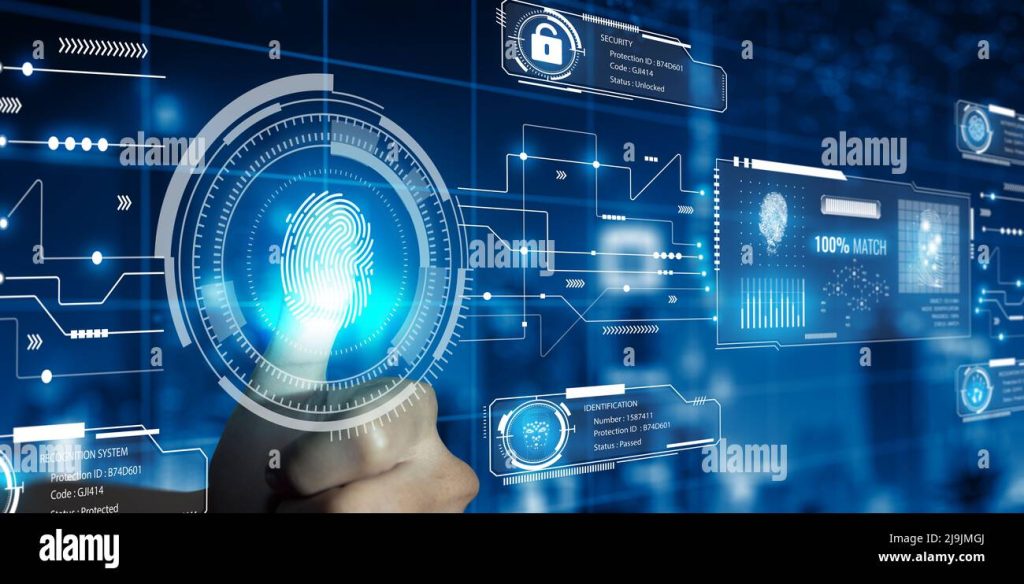Biometric authentication is the future of secure access and is gradually becoming more prevalent in various industries worldwide. The use of biometric traits such as fingerprints, facial scans, and retinal patterns eliminates the need for passwords, opt-out codes, and pins.
The technology behind biometrics authentication leverages physical and behavioral characteristics that are unique to each individual, ensuring a higher level of security. As technology advances, the implementation of biometric authentication will continue to grow, with a projected market size of over $50 billion in 2021.
The advantages of biometric authentication surpass traditional security measures in terms of accuracy, convenience, and accessibility. This article explores the importance of biometrics authentication and its potential benefits for businesses, individuals, and the digital world as a whole.

Credit: www.amazon.com
The Growing Need For Biometric Authentication
Biometric authentication has been gaining ground as a reliable method of securing access to sensitive information or physical spaces. In a world where cybercrime and physical theft are always a threat, traditional authentication methods, such as passwords and codes, are no longer adequate to guarantee security.
Biometric authentication provides a more secure, efficient, and cost-effective option, eliminating the need for passwords.
Increasing Security Threats And The Inadequacy Of Traditional Authentication Methods
Traditional authentication methods, such as passwords, pins, and security cards, have been the norm for some time. However, these methods have proven to be inefficient, outdated, and easy to hack. With the rise of cybercrime, phishing attacks, and data breaches, the need for more reliable authentication methods has become more apparent.
- Passwords can be easily compromised or stolen, and estimates reveal that over 80% of all data breaches result from stolen or weak passwords.
- Security cards can be lost or stolen, leaving a gap in the security chain.
- Pins can be hacked and are vulnerable to phishing and social engineering tactics.
The Promise Of Biometric Authentication In Providing Unbeatable Security
Advancements in technology have facilitated the emergence of biometric authentication as a reliable method for securing access. Biometric authentication relies on unique physiological or behavioral characteristics of an individual to grant access. These characteristics cannot be easily replicated or stolen, making biometric authentication one of the most secure methods of securing access.
- Biometric authentication relies on unique biological features such as fingerprints, face recognition, retina scan, and voice recognition, which makes it almost impossible to bypass.
- Biometric features are unique to an individual, and this makes it possible to eliminate identity spoofing, reducing the chances of impersonation fraud.
- Biometrics do not require anyone to remember a code or password, making it a more user-friendly authentication method that eliminates the need for resetting passwords.
Biometric authentication represents the future of secure access to sensitive information or physical spaces. The growing need for more efficient and reliable security methods has facilitated the emergence of biometrics as one of the most secure authentication methods. With its unbeatable security and user-friendly nature, it represents a solution that is not only secure but also convenient and efficient.
The Various Types Of Biometric Authentication Technologies
Biometric authentication technology is becoming increasingly popular and is set to be the future of secure access. Biometric authentication technologies include fingerprint scanning, iris scanning, facial recognition, and voice recognition, each with its unique advantages and drawbacks. In this section, we will discuss each of these technologies and their various applications.
Fingerprint Scanning And Its Varied Applications
Fingerprint scanning is one of the most commonly used biometric authentication technologies due to its ease of use and accuracy. It involves scanning the fingerprint patterns on an individual’s fingertip to authenticate their identity. Below are some of the varied applications of fingerprint scanning:
- Fingerprint scanning is widely used in the payment industry to ensure secure transactions.
- It is commonly used in law enforcement agencies to identify criminals and match their fingerprints with the existing database.
- Fingerprint scanning can be integrated into access control systems to ensure secure entry into restricted areas.
- It is also used in personal devices such as smartphones for convenient and secure unlocking.
Iris Scanning And Its Advantages Over Other Technologies
Iris scanning is a highly accurate biometric authentication technology that involves scanning the unique patterns in an individual’s iris to authenticate their identity. It offers several advantages over other technologies, including:
- Iris scanning is less prone to error as the iris patterns are highly unique.
- It is non-invasive and hassle-free, making it more user-friendly.
- Iris scanning is robust, and the iris patterns do not change even with aging, making it a reliable long-term solution for biometric authentication.
Facial Recognition And Its Limitations
Facial recognition is one of the most convenient biometric authentication technologies as it involves scanning an individual’s face to confirm their identity. It has both advantages and drawbacks. Here are some of the limitations of facial recognition:
- Facial recognition is less secure as the face can be easily altered with makeup or facial hair.
- The accuracy of facial recognition is dependent on lighting and angle, which can affect its effectiveness.
- It is also less reliable when used on younger faces or older faces with fewer unique features.
Voice Recognition And Its Practical Applications
Voice recognition is a biometric authentication technology that involves analyzing an individual’s voice to authenticate their identity. It is a convenient and non-invasive method that has practical applications, including:
- Voice recognition is used in call centers to authenticate customers’ identities and reduce fraud.
- It can also be used in smart homes to control security and lighting by recognizing the homeowner’s voice.
- Voice recognition can be integrated into wearable devices such as smartwatches for easy and secure access.
Biometric authentication technologies are becoming more prevalent in our society, and each technology offers unique advantages and limitations. Understanding each technology’s strengths and weaknesses is crucial in determining which biometric authentication technology is best suited for different applications.
The Benefits Of Biometric Authentication For Authentication In Business And Government Settings
Biometric Authentication And Improved Fraud Prevention
With traditional access control methods like passwords, pins, and tokens, there is always a chance that an unauthorized person can gain access to sensitive information by guessing or stealing login credentials. However, biometric authentication can enhance security and prevent fraud.
Here are some advantages of biometric authentication for improved fraud prevention:
- Biometric identifiers like fingerprint, face, iris, or voice are unique to an individual and cannot be easily replicated or forged by fraudsters.
- Biometric authentication is harder to hack or spoof because it requires a physical presence of the authorized user.
- Biometric authentication eliminates the need for passwords or tokens, which are vulnerable to social engineering, phishing, and other forms of cybercrime.
- Biometric authentication can also detect and prevent insider threats, where an authorized employee or contractor may try to misuse access privileges for personal or malicious purposes.
Biometric Authentication Technologies And Improved Customer Experience
In business settings, customer experience is critical for building trust, loyalty, and referrals. Biometric authentication can help to improve the overall customer experience in several ways. Here are some benefits of biometric authentication for better customer experience:
- Biometric authentication can speed up the login or checkout process, as customers do not need to remember or enter passwords or pins.
- Biometric authentication can reduce the risk of errors or typos in entering login credentials, which can frustrate customers and cause delays or rejections.
- Biometric authentication can increase the perceived security and trustworthiness of an online or mobile platform, which can promote customer satisfaction and retention.
- Biometric authentication can personalize the user experience by recognizing and validating the identity of the customer, which can lead to customized offers, recommendations, and incentives.
Biometric Authentication And Better Compliance With Regulatory Requirements
In both business and government settings, compliance with regulatory requirements is a top priority to avoid fines, lawsuits, and reputational damage. Biometric authentication can help organizations to comply with several types of regulations that require strong authentication and data protection.
Here are some ways that biometric authentication can facilitate better compliance:
- Biometric authentication can satisfy the authentication requirements of regulations like gdpr, hipaa, pci-dss, and psd2, which mandate the use of multi-factor authentication for accessing sensitive data or performing high-risk transactions.
- Biometric authentication can reduce the risk of data breaches, which can be costly and damaging for both customers and organizations under regulations like ccpa, glba, and sox.
- Biometric authentication can increase the accountability and traceability of access events, which can help organizations to fulfill audit and reporting requirements under regulations like iso 27001, nist, and soc 2.
Biometric authentication offers a wide range of benefits for authentication in business and government settings, including improved fraud prevention, customer experience, and compliance with regulatory requirements. By adopting biometric authentication technologies, organizations can enhance their security posture, increase their efficiency, and earn the trust and loyalty of their stakeholders.
Frequently Asked Questions On Biometric Authentication: The Future Of Secure Access
How Does Biometric Authentication Work?
Biometric authentication uses unique physical or behavioral characteristics to verify identity, such as fingerprints, iris scans, or voice recognition.
Is Biometric Authentication More Secure Than Traditional Passwords?
Yes, biometric authentication offers higher levels of security as it is difficult to replicate someone’s unique physical or behavioral characteristics.
What Are Some Benefits Of Using Biometric Authentication?
Biometric authentication eliminates the need to remember complex passwords, increases security by reducing the risk of identity theft, and provides a faster and more convenient way of accessing personal devices and accounts.
Conclusion
Biometric authentication is a game-changer in the world of secure access. It offers a fool-proof solution that does not require users to remember complex passwords or to carry keycards. Biometric authentication is a secure and convenient method of verifying identity that takes into account unique bodily features.
It is difficult to replicate, making it an ideal option for businesses, governments, and individuals seeking to protect sensitive information. Biometric authentication is gaining widespread acceptance, and it is predicted that it will continue to grow in popularity in the coming years.
While this technology is not without its challenges, including privacy concerns and cost, it is a step in the right direction to combat cybercrime and improve security in both physical and digital realms. As we look to the future, biometric authentication is an essential tool to keep our information and infrastructure safe.

